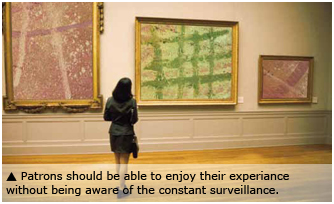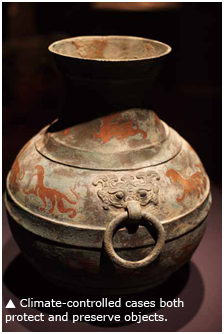THE SECURITY WITHIN Security cameras must be able to view all corners of the museum and keep an eye on any abnormalities without making visitors feel like they are under constant surveillance. Currently, older analog cameras are most widely used in museums because they are a legacy product. Their quality is generally acceptable to most museum applications and their asthetics are more appealing in some cases, Lazuta said. In some museums all cameras, both legacy analog or new network cameras, are integrated with sound and alarm systems to alert visitors that they are stepping too close and to notify guards of any possible intrusions.
THE SECURITY WITHIN
Security cameras must be able to view all corners of the museum and keep an eye on any abnormalities without making visitors feel like they are under constant surveillance. Currently, older analog cameras are most widely used in museums because they are a legacy product. Their quality is generally acceptable to most museum applications and their asthetics are more appealing in some cases, Lazuta said. In some museums all cameras, both legacy analog or new network cameras, are integrated with sound and alarm systems to alert visitors that they are stepping too close and to notify guards of any possible intrusions.
According to Sinar, it is still predominantly an analog market, with only 5 percent being IP. However, many museums are making the move to implement an IP-based security system and are using encoders on their old analog cameras. One of the benefits of IP is that data can now be easily transmitted to other locations for information exchange within the estate, or passed to third parties such as the police or insurance companies, Makosinski said.
Many museums in the U.K., for example, choose to outsource their central monitoring to specialists. “Many systems are connected to alarm-receiving centers. They will notify museum authorities of detectors that are or have been tampered with and of any suspicious movement in off-limit areas,” Barwell said.
Due to budget concerns, not all museums can make the move to a full-IP system at once. “We are slowly migrating into IP because budget limits us from using network devices in certain areas. We only replace our old devices when they no longer work,” Chi said. Many users might choose to deploy a hybrid system, which allows them to take advantage of the newer technologies and software that come with an IP-based system, Sinar said.
 The biggest barrier against megapixel and HD technology is the amount of bandwidth required to transmit data effectively. “The bandwidth requirement for a megapixel camera can be as much as 15 times greater than a regular network camera. However, one megapixel or HD camera can replace up to nine network or analog cameras, and the software can identify different streams within one picture. Users need to realize that this can help cut costs even if more bandwidth is required,” Sinar said.
The biggest barrier against megapixel and HD technology is the amount of bandwidth required to transmit data effectively. “The bandwidth requirement for a megapixel camera can be as much as 15 times greater than a regular network camera. However, one megapixel or HD camera can replace up to nine network or analog cameras, and the software can identify different streams within one picture. Users need to realize that this can help cut costs even if more bandwidth is required,” Sinar said.
Although the uptake is slow, investments have been placed over the last few years into network cameras and systems. “More requests are coming in for network cameras because museums see the added value of megapixel and HD technology,” Van Waelderen said.
Video Content Analysis
Video analytics are slowly introduced into the market with museums and historical sites becoming prime clients for the technology, Barwell said. The technology can automatically alert authorities to visitors getting too close or if an object is removed from its usual place. “This way, the burden of monitoring multiple camera feeds is removed, allowing the operator to work much more proactively in terms of responding to actual incidents. Video analytics can also be used to detect objects that have been left behind within a scene, alerting the operator to questionable packages,” Makosinski said. Also, it is impossible to watch, say, 150 cameras at once, said Ken Platt, Facility Director of the Butler Institute of American Art.
Until recently, wireless alarms were mostly called upon, hidden behind paintings or in exhibit cases, to protect collections. “But intelligent video can allow visitors to move freely within the space and alert the security personnel in the control room and the guard in the exhibit galleries only when someone attempts to touch or remove the protected object,” Lazuta said. “Protective zones are drawn around objects, and alerts can be sent also in the form of an e-mail or a text message.”
Proper attention in installation and configuration should be paid to prevent false alarms. “Anything from a reflection or a shadow can set off an alarm if it is not programmed to ignore these movements,” Lazuta said. "There are solutions uniqely programmed for museums to elimate these false alarms."
 Alarms and RFID
Alarms and RFID
All museums have grey hours in the morning and at the end of each day during which the guards have yet to report to duty, most contractor activity occurs and only limited staff are present. Many museum incidents occur during these hours, Lazuta said. “Only an alarm on each object on display can really be effective.”
RFID tags can be used to effectively keep track of exhibited items. “Tags can be placed within the base structure of the display cases to create a covert system,” said Rob Green, MD of ISIS. “For example, at the Historic Royal Hampton Court Palace, concealed RF readers were installed in the roof cavities to read the tagged artworks below. Full radio coverage was achieved through using a range of different antennae.”
Tracking all items can also help curators better design their exhibition layout. “Software can be used to deliver comprehensive tag data analysis of the frequency of when an item is touched — monitoring individual artworks help curators deisgn the best exhibition layout,” Green said.
To ensure excellent radio frequency coverage with no "radio holes", a minimum of two readers should provide coverage for any given area, Green said. "This is also good for redundancy should a reader fail or the frequency jam on one of the readers."
WIRELESS TRANSMISSION
 Wired transmission is considered far more reliable and many sites already have the cabling in place, but since many historical sites and buildings limit the extent of renovations allowed, wireless solutions have been on the rise. “Aside from site preservation, a cost benefit can be realized since ripping up floors and pulling down ceilings can be costly. Generally, one would minimize cabling if possible,” Barwell said.
Wired transmission is considered far more reliable and many sites already have the cabling in place, but since many historical sites and buildings limit the extent of renovations allowed, wireless solutions have been on the rise. “Aside from site preservation, a cost benefit can be realized since ripping up floors and pulling down ceilings can be costly. Generally, one would minimize cabling if possible,” Barwell said.
Sandell advises that systems should utilize the latest wireless technology to prevent phone lines from being severed, rendering the system ineffective.
Another advantage of using wireless technology is the ability to add and remove temporary security areas. “Since there is no need for cabling, the process is fast, efficient and effective,” Wan said.
Larger complexes may benefit from a wireless system as well. “However, the remoteness of the site, cost and the existing infrastructure are all factors in determining how suitable wireless would be. Smooth video transmission may rack up a large expense for certain sites,” Barwell said.
 Heritage , Protected
Heritage , Protected
Every museum is different, and the nature of the collection must be considered. For example, Chinese art is mainly composed of scrolls and thin sheets of paper or bronze ware, which must be placed in a climatecontrolled environment. Other items, such as small jade ornaments, are delicate and must also be placed behind glass. “The display cases perform two objectives — security and conservation. The glass used for our display cases is bullet-, fire- and explosion-proof,” Chi said.
One of the biggest challenges with historical sites is resource allocation. “While integrating all systems into the daily running of the museum itself, one must make sure that the right procedures and processes are in place; a single product or security discipline is not enough,” Barwell said.
Many security decisions are made by museum curators or directors who are not trained to deal with such problems. “It is best to hire a security consultant or a head of security who is trained and has had extensive experience in this field,” Hill said. Quality systems that are properly installed, well-maintained and audited can play a significant part in the protection of tradition, heritage, and many of the world's priceless works of art.
Next - Part Ⅰ:Securing and Preserving Cultural Heritage